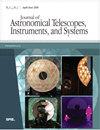Comparative laboratory study of electric field conjugation algorithms
IF 3.1
3区 工程技术
Q2 ENGINEERING, AEROSPACE
Journal of Astronomical Telescopes Instruments and Systems
Pub Date : 2024-07-01
DOI:10.1117/1.jatis.10.3.035001
引用次数: 0
Abstract
Future space telescope coronagraph instruments hinge on the integration of high-performance masks and precise wavefront sensing and control techniques to create dark holes essential for exoplanet detection. Recent advancements in wavefront control algorithms might exhibit differing performances depending on the coronagraph used. This research investigates three model-free and model-based algorithms in conjunction with either a vector vortex coronagraph or a scalar vortex coronagraph under identical laboratory conditions: pairwise probing with electric field conjugation, the self-coherent camera with electric field conjugation, and implicit electric field conjugation. We present experimental results in narrowband and broadband light from the In-Air Coronagraph Testbed at the Jet Propulsion Laboratory. We find that model-free dark hole digging methods achieve broadband contrasts comparable to model-based methods, and we highlight the calibration costs of model-free methods compared with model-based approaches. This study also reports the first time that electric field conjugation with the self-coherent camera has been applied for simultaneous multi-subband correction with a field stop. This study compares the advantages and disadvantages of each of these wavefront sensing and control algorithms with respect to their potential for future space telescopes.电场共轭算法的实验室比较研究
未来的空间望远镜日冕仪仪器取决于高性能掩模与精确波前传感和控制技术的整合,以产生系外行星探测所必需的暗洞。波前控制算法的最新进展可能会根据所使用的日冕仪而表现出不同的性能。本研究在相同的实验室条件下,结合矢量涡旋日冕仪或标量涡旋日冕仪,研究了三种无模型和基于模型的算法:电场共轭成对探测、电场共轭自相干相机和隐式电场共轭。我们介绍了喷气推进实验室空中日冕仪试验台在窄带和宽带光下的实验结果。我们发现,无模型暗洞挖掘方法获得的宽带对比度与基于模型的方法相当,我们还强调了无模型方法与基于模型方法相比的校准成本。本研究还首次报道了自相干相机的电场共轭技术在多子带同步校正中的应用。本研究比较了每种波前传感和控制算法的优缺点,以及它们在未来空间望远镜中的应用潜力。
本文章由计算机程序翻译,如有差异,请以英文原文为准。
求助全文
约1分钟内获得全文
求助全文
来源期刊

Journal of Astronomical Telescopes Instruments and Systems
Engineering-Mechanical Engineering
CiteScore
4.40
自引率
13.00%
发文量
119
期刊介绍:
The Journal of Astronomical Telescopes, Instruments, and Systems publishes peer-reviewed papers reporting on original research in the development, testing, and application of telescopes, instrumentation, techniques, and systems for ground- and space-based astronomy.
 求助内容:
求助内容: 应助结果提醒方式:
应助结果提醒方式:


